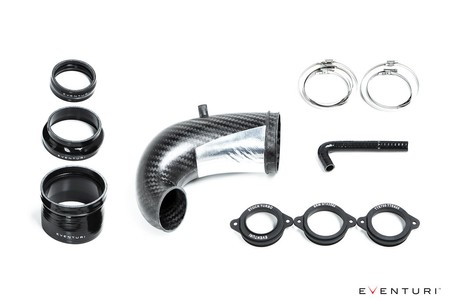Repeating the code many times will add this item as many times as it appears.
Eventuri Turbo Inlet Audi RS3 / TTRS Gen 2 8V 8Y RHD Carbon without Flange
Turbocharger Hose for AUDI RS3 TTRS
Power gains (RS3 with hybrid turbocharger): 14-20 HP, 30-35 Nm
Increased flow at 24″ H2O: 42% increase compared to standard (Using standard mounting)
Fits RS3 8V Gen 2, 8Y RS3, F3 RSQ3, and TTRS 8S on right and left-hand drive systems. Finished in raw carbon fiber - without protective coating.
Optional mountings are available for popular hybrid turbochargers.
Introducing a world-first - completely carbon fiber RS3/TTRS turbocharger hose. We've invested months of intensive research and development to create an inlet that leaves no room for compromise.
VOLUME - FLOW QUALITY - TEMPERATURE are the three main design criteria we set out to meet.
- VOLUME:
Inlet diameters - Eventuri 103 mm, standard 72 mm.
Outlet diameters - Eventuri 74 mm, Standard 56.4 mm.
Clearly, due to significantly larger internal diameter sizes, the Eventuri hose encompasses a much larger internal volume, freeing up the flow path to the turbocharger. - FLOW QUALITY:
Having just a large internal volume doesn't make sense if the flow path also enables smooth airflow to the turbocharger. By using high-temperature pre-impregnated carbon, we've managed to achieve a smooth inner surface. In contrast, standard and other hoses available in the market are made of cast aluminum, ending up with a rough inner surface. This, combined with smooth elbow curvature, leads to a flow path that minimizes turbulence. - TEMPERATURE:
The final criterion was to minimize heat conduction to the airflow. The standard inlet is directly connected to the turbocharger and immediately conducts heat as the turbocharger spins. Our system utilizes a seal made from machined flange, which mates to the turbocharger, then a flexible connector with an integrated thermal spacer to prevent direct contact of the carbon hose with the turbocharger. This insulation, combined with the low thermal conductivity of carbon in the transverse direction, results in less heat transfer to the airflow.
Performance Tests
We conducted flow tests using the Superflow SF-1020 to measure maximum flow at a pressure drop of 28” H2O. Tests were conducted under controlled conditions on the same day, using the same test fixture for each hose. The results show how restrictive the standard intake is, which we managed to improve from 42% using standard mounting to up to 58% in maximum possible flow using the larger GTX mounting. Since the RHD version requires space for the brake fluid reservoir, we added cuts on the sides, reducing the volume of the pipe, but still maintaining a significant flow increase compared to standard, increasing it by 52% compared to standard using the GTX mounting.
Dynamometer Tests
Our carbon hose has been independently tested by renowned tuners worldwide. The first set of results comes from BR Performance Netherlands, who tested our system on a TTRS equipped with a TTE700 hybrid turbocharger. The tests were conducted on the same day, with the engine bay closed. They tested the standard airbox with our stage 3 intake with a standard hose, and then added our intake for comparison.
Summary of Dynamometer Results:
Standard airbox with modified standard inlet for TTE700 = 576.5 HP
Eventuri Intake stage 3 with modified standard inlet for TTE700 = 606.5 HP
Eventuri Intake stage 3 with Eventuri inlet for TTE700 = 620.8 HP

Turbocharger Intake Kit

The Eventuri RS3 8V / TTRS 8S hose is made of high-temperature pre-impregnated carbon fiber and is equipped with a series of other components designed to meet a specific purpose and manufactured to the highest standards.
Fittings are available for vehicles with right-hand drive (RHD) and left-hand drive (LHD). The inlet is designed to fit our RS3 8V / TTRS 8S Stage 2 and Stage 3 air intake systems.
Each inlet system consists of:
- High-temperature carbon fiber intake hose - Specific to RHD and LHD
- CNC machined turbocharger flanges - optional choices
- Silicone connectors with oil-resistant lining
- Marine grade stainless steel brackets (Grade 316)

Carbon Fiber Intake Elbow

Our turbocharger inlet provides a smooth flow path from 103 mm inlet diameter to 74 mm outlet to the turbocharger plane. We've designed it with continuous curvature and maximized internal volume, positively impacting airflow. The inlet is finished in raw carbon, so it lacks a protective coating - which wouldn't withstand the heat generated by the turbocharger and exhaust manifold. The carbon fiber construction allows us to maintain a smooth inner surface, aiding in reducing surface friction and facilitating airflow. We ensure strength and rigidity, maintaining a wall thickness of 2 mm throughout. Finally, for additional protection, a heat reflective layer is applied at the junction with the exhaust manifold, reducing the radial heat absorbed by the pipe. The advantages of using carbon fiber compared to traditionally used cast aluminum mainly lie in thermal conductivity and the ability to maintain smoothness inside. The table below summarizes the benefits.

Minimizing Component Heating

During acceleration, the RS3/TTRS turbocharger generates intense heat as it spools up. Since the front portion of the turbocharger is directly connected to our CNC flange, we designed a silicone connector that also acts as a thermal barrier between the carbon fiber pipe and the metal flange. Internally, the silicone has a space that separates the carbon fiber and metal surfaces. This reduces heat conduction and allows for more consistent power output, as the inlet doesn't heat up as quickly as the standard one.
CNC Machined Flanges

We offer a choice of turbocharger flanges, which are CNC machined from aerospace-grade aluminum and anodized.
Currently available flanges:
- Standard Turbocharger
- TTE 700 / 625
- SRM GTX3582


















